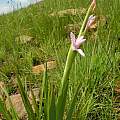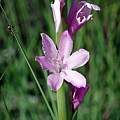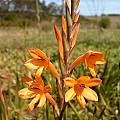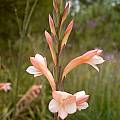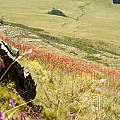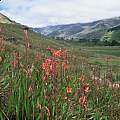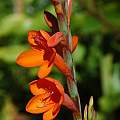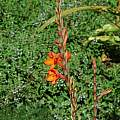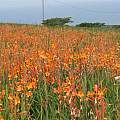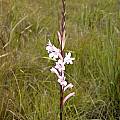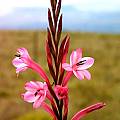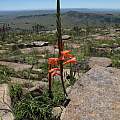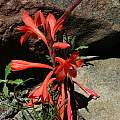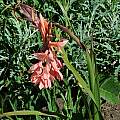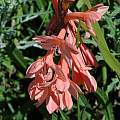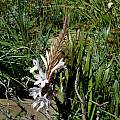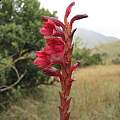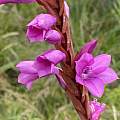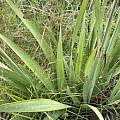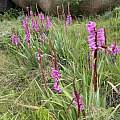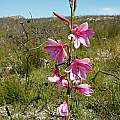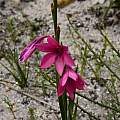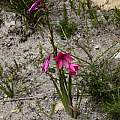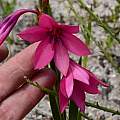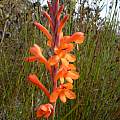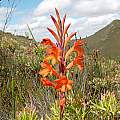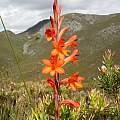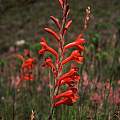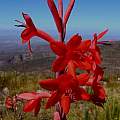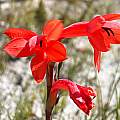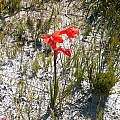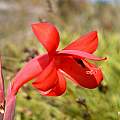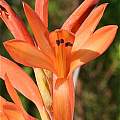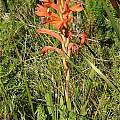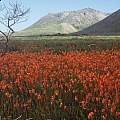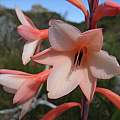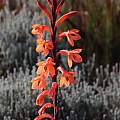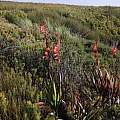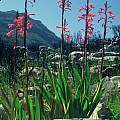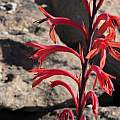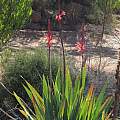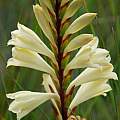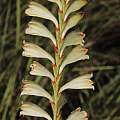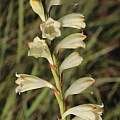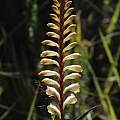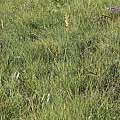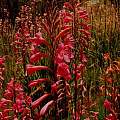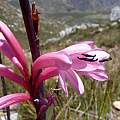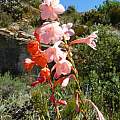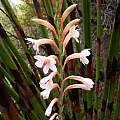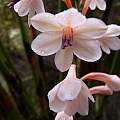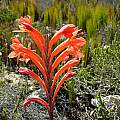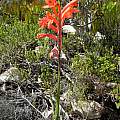Watsonia is a genus in the Iridaceae family of over 50 species in southern Africa where it is distributed from the mountains and coastal belt of the Western Cape to the Drakensberg escarpment of Swaziland and the eastern Transvaal. It therefore grows in both the winter and summer rainfall areas. Growing from a corm, species are both evergreen and perennial. Many are quite tall with fans of sword-shaped leaves and spikes of showy (often many) flowers that are usually pink, bright red or orange. Watsonia species n-z are found on this page.
Watsonia species a-f - Watsonia species g-m - Watsonia index
Watsonia occulta L. Bolus is distributed from Mpumalanga to Swaziland in Southern Africa where it grows in mountain grassland. Growing from 18 to 40 cm, it has bilaterally symmetrical pale pink flowers with a long tube and long floral bracts that clasp and conceal the stem. The first photo was taken by Rod Saunders. The next two photos from iNaturalist were taken by thinus in Kkangala in December and shared under a CC BY-NC license.
Watsonia pillansii L. Bolus, syn. Watsonia beatricis J.W.Mathews & L.Bolus , syn. Watsonia socium J.W.Mathews & L.Bolus, is found from the Eastern Cape to KwaZulu-Natal where it is found in sandy soils mostly at low elevations near the coast. It usually has scarlet to orange flowers and is evergreen, preferring year round moisture. It grows 50-120 cm high, and flowers late spring to summer. The first two pictures show variations in the color of the flowers and the third a large number blooming in habitat. Photos by Cameron McMaster. The fourth picture was taken by Rod Saunders. The last two photos were taken January 2010 in the Kirstenbosch National Botanical Garden by Mary Sue Ittner.
Photos 1-2 show a flowering in mass at Potter's Pass near East London in October 2007, photos 3-4 are of rare pink flowers, and photo 5 was taken at Gaika's Kop. Photos from Cameron McMaster. The last photo was also taken at Gaika's Kop by Mary Sue Ittner.
According to Peter Goldblatt in his monograph, The Genus Watsonia, this species is difficult to tell apart from Watsonia knysnana and when it is in the same range a series of intermediates can be found. These are hybrids with variability of bract length and flower color from cream to pale pink to red or maroon. Plants seen January 2010 and photographed by Mary Sue Ittner near Hogsback on Gaika's Kop could be either of these species or hybrids of the two.
Watsonia pulchra N.E.Brown ex Goldblatt plants grow in open grassland or light woodland from northeastern Natal through Swaziland and the eastern Transvaal. This species grows from 60 to 120 cm high and has a spike of 30 to 60 pink to purple, or maroon, occasionally white, flowers. It is distinguished by its dry brown bracts that clasp the stem. It flowers in the summer. The first photo was taken by Rod Saunders. The other photos from iNaturalist were taken by Linda Loffler in Swaziland in February and shared under a CC BY-NC license
Watsonia rogersii L.Bolus grows on rocky sandstone slopes and also in granite and clay in the Southwest Cape. It grows to 50 cm high and has lax, sometimes branched, spikes of purple-pink flowers and blooms from October to December. The first photo was taken by Cameron McMaster in the Overberg at Houwhoek Pass. Other photos from iNaturalist were taken by Vera Frith in November near Hermanus and shared under a CC BY-NC license.
Watsonia schlechteri L.Bolus grows on rocky sandstone slopes in fynbos over a wide area of the Cape Province. Flowering mainly after fire, this species grows from 40 to 100 cm high and has scarlet flowers in an elongate spike. Photos 1 to 3 by Cameron McMaster were taken at Napier and Boskloof in the Overberg. The fourth photo was taken by Rod Saunders from Silverhill Seeds. The last photo from the book Plants of the Klein Karoo courtesy of J and A Vlok.
Watsonia socium is a synonym for Watsonia pillansii
Watsonia spectabilis Schinz is native to sandy flats and plateaus, often found near water, from the Western Cape to the Agulhas Plains. It grows from 25 to 50 cm. high and has large tubular scarlet flowers in a few-flowered spike. Photos 1-3 were taken by Cameron McMaster near Napier in the Overberg. Photos 4-6 were taken by Andrew Harvie west of Stellenbosch in the Western Cape.
Watsonia stenosiphon L.Bolus grows on coarse rocky sandstone soils along the southern Cape coast. It rarely blooms except after fires, but then blooms in profusion the spring following a fire in the previous summer or fall. It grows from 20 to 45 cm. and has a slender long narrow perianth tube. Flowers are salmon-orange, occasionally mauve, often with a darker line in the lower midline of the lower three tepals. Photos were taken by Audrey Cain and Rod Saunders.
Watsonia tabularis J.W.Mathews & L.Bolus is found on rocky sandstone soils in the southwestern Cape. Growing to 1.5 m high, this species has sword-shaped leaves with inflated cauline leaves and orange or pink flowers in an elongate branched spike. It flowers November to December. The first photo was taken by Rod Saunders. The next two photos from iNaturalist were taken by Tony Rebelo in January in the Southwestern Cape and shared under a CC BY-SA license.
Watsonia vanderspuyae L.Bolus is found in the western Cape mountains at mid to upper elevations where it grows in rocky situations, often wedged in crevices where it is protected from predation. It grows to 2 meters and has broad leaves with thickened margins and large bright red long tubed flowers. It blooms infrequently in the wild and sometimes leaves are not produced unless there have been fires in the previous summer. The first photo was taken by Rod Saunders. The other photos from iNaturalist were taken by Felix Riegel in the Western Cape in October and shared under a CC BY-NC license.
Watsonia versfeldii J.W.Mathews & L.Bolus is found on sandstone slopes in the Northwest Cape. It is a tall plant (1-2 m high) with pink-purple flowers in an elongate branched spike. It flowers in the spring (October-November).
Watsonia watsonioides (Baker) Oberm. occurs in the southeastern Transvaal and Swaziland. It grows in rocky grassland usually between 1300-1800 m but as low as 100 m. It flowers from December-January to March (Goldblatt, 1989). Growing from .5 to 1 m, it has zygomorphic pale yellow to cream (or maroon) flowers. The spike is congested with 25 to 50 or more flowers on the main axis; the outer bracts are green at the base, clasping only at the base and the inner are brown and deeply forked. This species is distinguished by having small flowers, a relatively dense and many-flowered spike and one or two narrow, linear basal leaves with heavily thickened margins. The flower color is unique in Watsonia. Nick de Rothschild photographed the cream colored flower in the first photo 26 December on the hillsides of Mpumalanga, South Africa. The next four photos from iNaturalist were taken by Tony Rebelo in February in the Malolotja Nature Reserve and shared under a CC BY-SA license.
Watsonia wilmaniae J.W.Mathews & L.Bolus is found in moist sites in fynbos on the coastal and inland mountains from Ladismith to Kynsna. Growing from .8 to 1.5 m, it has pink, purple, orange, or red flowers on an often branched stem and sword-shaped leaves. It flowers in summer. The first photo below from the book Plants of the Klein Karoo courtesy of J and A Vlok. The rest of the photos from iNaturalist were taken by Marge in January and February near the Swartberg Pass and shared under a CC BY-NC license.
Watsonia zeyheri L.Bolus grows in marshes on sandstone from the Cape Peninsula to the Agulhas coast. This species grows from 50 to 120 cm high and has bright orange flowers. It blooms late spring into summer. Photos by Cameron McMaster taken November 2005 at Arniston in the Overberg.
Watsonia species a-f - Watsonia species g-m - Watsonia index
